Readings Newsletter
Become a Readings Member to make your shopping experience even easier.
Sign in or sign up for free!
You’re not far away from qualifying for FREE standard shipping within Australia
You’ve qualified for FREE standard shipping within Australia
The cart is loading…






This title is printed to order. This book may have been self-published. If so, we cannot guarantee the quality of the content. In the main most books will have gone through the editing process however some may not. We therefore suggest that you be aware of this before ordering this book. If in doubt check either the author or publisher’s details as we are unable to accept any returns unless they are faulty. Please contact us if you have any questions.
When offenses are neither serious, violent, nor chronic, it is typically viewed as acceptable to let the family take care of the problem. In this context, juvenile court is properly seen as a court of last resort. But at some point, the seriousness, violence, or repetitiveness of a juvenile's criminality suggests the family should relinquish control and that society should not entrust the problem to the attention and limited resources of the family. In this context, the responsibility for addressing and controlling the problem youth belongs to a "higher" power, namely the juvenile court. The same can be said of the juvenile court and the limits society wants to bestow upon that institution. The juvenile court may be a court of last resort, but it surely is not a court of only resort.
Realizing the Purpose and Benefits of Juvenile Transfer to Criminal Court explains that, at some point, the juvenile court should relinquish control when particularly serious, chronic offending is involved. Society needs to rely upon the criminal court to prosecute some chronic and violent juvenile offenders. It presents the myriad benefits stemming from and purposes served by the prosecution of these youths' occurring in criminal court. Covering topics such as benefactors of transfer, juvenile court, and moral condemnation, this premier reference source is an excellent resource for juvenile court workers, court administrators, sociologists, criminal court workers, prosecutors, students and educators of higher education, librarians, researchers, and academicians.
$9.00 standard shipping within Australia
FREE standard shipping within Australia for orders over $100.00
Express & International shipping calculated at checkout
This title is printed to order. This book may have been self-published. If so, we cannot guarantee the quality of the content. In the main most books will have gone through the editing process however some may not. We therefore suggest that you be aware of this before ordering this book. If in doubt check either the author or publisher’s details as we are unable to accept any returns unless they are faulty. Please contact us if you have any questions.
When offenses are neither serious, violent, nor chronic, it is typically viewed as acceptable to let the family take care of the problem. In this context, juvenile court is properly seen as a court of last resort. But at some point, the seriousness, violence, or repetitiveness of a juvenile's criminality suggests the family should relinquish control and that society should not entrust the problem to the attention and limited resources of the family. In this context, the responsibility for addressing and controlling the problem youth belongs to a "higher" power, namely the juvenile court. The same can be said of the juvenile court and the limits society wants to bestow upon that institution. The juvenile court may be a court of last resort, but it surely is not a court of only resort.
Realizing the Purpose and Benefits of Juvenile Transfer to Criminal Court explains that, at some point, the juvenile court should relinquish control when particularly serious, chronic offending is involved. Society needs to rely upon the criminal court to prosecute some chronic and violent juvenile offenders. It presents the myriad benefits stemming from and purposes served by the prosecution of these youths' occurring in criminal court. Covering topics such as benefactors of transfer, juvenile court, and moral condemnation, this premier reference source is an excellent resource for juvenile court workers, court administrators, sociologists, criminal court workers, prosecutors, students and educators of higher education, librarians, researchers, and academicians.